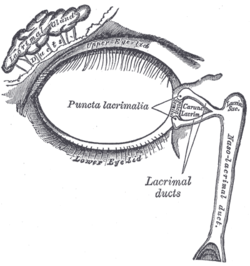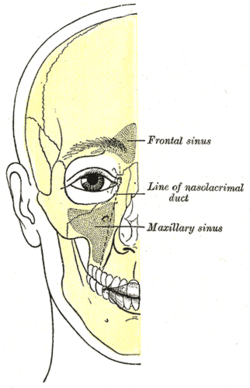비루관
Nasolacrimal duct| 비루관 | |
|---|---|
 누액 기구.오른쪽. | |
 얼굴 뼈의 윤곽, 공기 부비강 위치를 보여줍니다. | |
| 세부 사항 | |
| 식별자 | |
| 라틴어 | 코딱지관 |
| 메쉬 | D009301 |
| TA98 | A15.2.07.070 |
| TA2 | 6859 |
| FMA | 9703 |
| 해부학 용어 | |
비루관(일명 눈물관)은 눈물을 눈의 누낭에서 비강으로 [1][2]운반합니다.도관은 상악골과 누골 사이의 안와에서 시작되며, 아래쪽으로 지나가고 뒤로 지나갑니다.비강의 하비강으로 들어가는 비루관의 개구부는 부분적으로 점막주름(Hasner 또는 Plica lacrimalis)[3]으로 덮여 있다.
과도한 눈물은 비루관을 통해 흘러서 하비강으로 흘러 들어간다.알레르기 때문에 눈물이 나거나 눈물이 날 때 콧물이 나고 가끔 안약을 맛볼 수 있는 이유다.같은 이유로 몇몇 안약을 바를 때, 약물이 눈에서 빠져나오지 않도록 손가락으로 눌러서 비강관을 닫는 것이 종종 권장됩니다. 그리고 약물이 비강으로 이동하기 때문에 체내 다른 곳에서 원치 않는 부작용을 일으킬 수 있습니다.
누낭과 마찬가지로 점액을 분비하는 고블렛 세포를 포함한 층상 주상피로 덕트를 배열한 후 결합조직으로 둘러싸여 있다.
임상적 의의
비루관이 막힐 [4][5][6]수 있습니다.이것은 에피포라라고 불리는 과도한 눈물 범람으로 [7]이어집니다.선천성 폐색은 덕트의 낭포 확장을 일으킬 수 있으며, 다크리오시스토셀레 또는 티모낭종이라고 불립니다.안구건조증 환자는 덕트를 밀봉하는 펑크 플러그를 장착하여 유체 배출량을 제한하고 수분을 유지할 수 있습니다.
귀 감염 동안, 과도한 점액은 비루관을 통해 눈물이 흐르는 [citation needed]반대 방향으로 흐를 수 있습니다.
비루관을 포함하고 있는 관을 비루관이라고 합니다.
인간의 경우,[8] 남성의 눈물관이 여성의 눈물관보다 더 큰 경향이 있다.
기타 이미지
「 」를 참조해 주세요.
레퍼런스
- ^ "Nasolacrimal System Anatomy: Embryology, Puncta, Canaliculi". 2020-02-19.
{{cite journal}}:Cite 저널 요구 사항journal=(도움말) - ^ Herbert, Ronald A.; Janardhan, Kyathanahalli S.; Pandiri, Arun R.; Cesta, Mark F.; Miller, Rodney A. (2018). "Nose, Larynx, and Trachea". Boorman's Pathology of the Rat. Elsevier. pp. 391–435. doi:10.1016/b978-0-12-391448-4.00022-8. ISBN 978-0-12-391448-4. S2CID 80517730.
The paired nasolacrimal ducts carry lacrimal secretions from the eye to the nasal cavity, and originate as oval openings near the edge of the medial canthus of the eyelids. Initially the duct is small and circular, but in the middle portion, the diameter increases and the appearance is more oblong and saccular. The diameter again decreases before the duct enters the ventrolateral nasal vestibule medial to the root of the incisor tooth approximately 2 mm caudal to the nares.
- ^ "Medical Definition of PLICA LACRIMALIS". Merriam-Webster Medical Dictionary. 2020-05-08. Retrieved 2020-05-08.
an imperfect valve at the opening of the nasolacrimal duct into the inferior meatus of the nose
- ^ CARREIRO, J (2009). "Head and neck". Pediatric Manual Medicine. Elsevier. pp. 13–97. doi:10.1016/b978-0-443-10308-7.00002-8. ISBN 978-0-443-10308-7.
Dacryostenosis is a condition whereby the nasolacrimal duct is narrowed or blocked and the glandular secretions into the eye are prevented from draining properly. The secretions collect around the orifice of the duct and in the corner of the eye, where they thicken, resulting in a gooey, sticky substance that further clogs any drainage route.
- ^ Stagner, Anna M.; Jakobiec, Frederick A.; Eagle, Ralph C.; Charles, Norman C. (2018). "Infections of the Eye and Its Adnexa". Diagnostic Pathology of Infectious Disease. Elsevier. pp. 648–685. doi:10.1016/b978-0-323-44585-6.00021-7. ISBN 978-0-323-44585-6.
Dacryocystitis is produced by obstruction of the nasolacrimal duct with resultant tear stasis. Clinically, patients display erythema and swelling of the lacrimal sac, creating a mass in the medial canthal area, centered below the medial canthal tendon.
- ^ "유아 눈물관 막힘" 2012-07-08년 Wayback Machine, Pediatric Views, 2006년 6월 보관.
- ^ Nerad, Jeffrey A.; Carter, Keith D.; Alford, Mark (2008). "Disorders of the Lacrimal System: Congenital Obstruction". Oculoplastic and Reconstructive Surgery. Elsevier. pp. 131–137. doi:10.1016/b978-0-323-05386-0.50010-7. ISBN 978-0-323-05386-0.
- ^ 월스트리트저널 '남자와 여자의 눈물'은 폭스뉴스 2011년 5월 5일자 '남자와 여자가 다른 눈물을 흘리는 이유'에 반영됐다.



